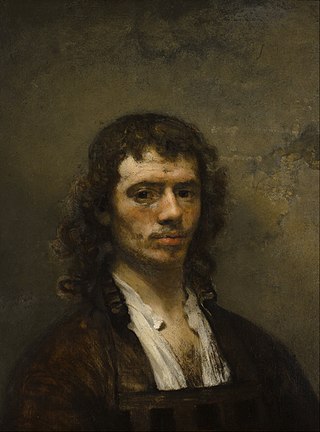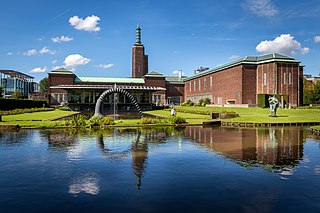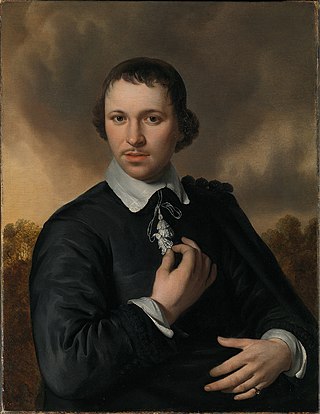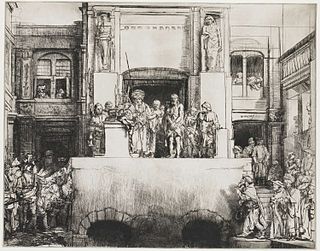
Frans Hals the Elder was a Dutch Golden Age painter, chiefly of individual and group portraits and of tronies, who lived and worked in Haarlem.

Carel Pietersz. Fabritius was a Dutch painter. He was a pupil of Rembrandt and worked in his studio in Amsterdam. Fabritius, who was a member of the Delft School, developed his own artistic style and experimented with perspective and lighting. Among his works are A View of Delft, The Goldfinch (1654), and The Sentry (1654).

Jan van Scorel was a Dutch painter, who played a leading role in introducing aspects of Italian Renaissance painting into Dutch and Flemish Renaissance painting. He was one of the early painters of the Romanist style who had spent a number of years in Italy, where he thoroughly absorbed the Italian style of painting. His trip to Italy coincided with the brief reign of the only Dutch pope in history, Adrian VI in 1522–23. The pope made him a court painter and superintendent of his collection of antiquities. His stay in Italy lasted from 1518 to 1524 and he also visited Nuremberg, Venice and Jerusalem. Venetian art had an important impact on the development of his style.

Hendrick Goltzius, or Hendrik, was a German-born Dutch printmaker, draftsman, and painter. He was the leading Dutch engraver of the early Baroque period, or Northern Mannerism, lauded for his sophisticated technique, technical mastership and "exuberance" of his compositions. According to A. Hyatt Mayor, Goltzius "was the last professional engraver who drew with the authority of a good painter and the last who invented many pictures for others to copy". In the middle of his life he also began to produce paintings.

Maarten van Heemskerck or Marten Jacobsz Heemskerk van Veen was a Dutch portrait and religious painter, who spent most of his career in Haarlem. He was a pupil of Jan van Scorel, and adopted his teacher's Italian-influenced style. He spent the years 1532–36 in Italy. He produced many designs for engravers, and is especially known for his depictions of the Wonders of the World.

Bartholomeus van der Helst was a Dutch painter. Considered to be one of the leading portrait painters of the Dutch Golden Age, his elegant portraits gained him the patronage of Amsterdam's elite as well as the Stadtholder's circle. Besides portraits, van der Helst painted a few genre pictures as well as some biblical scenes and mythological subjects.

Jan Lievens was a Dutch Golden Age painter who was associated with his close contemporary Rembrandt, a year older, in the early parts of their careers. They shared a birthplace in Leiden, training with Pieter Lastman in Amsterdam, where they shared a studio for about five years until 1631. Like Rembrandt he painted both portraits and history paintings, but unlike him Lievens' career took him away from Amsterdam to London, Antwerp, The Hague and Berlin.

Municipal Museum Boijmans Van Beuningen is an art museum in Rotterdam in the Netherlands. The name of the museum is derived from the two most important collectors of Frans Jacob Otto Boijmans and Daniël George van Beuningen. It is located at the Museumpark in the district Rotterdam Centrum, close to the Kunsthal and the Natural History Museum.

Rembrandt Harmenszoon van Rijn, usually simply known as Rembrandt, was a Dutch Golden Age painter, printmaker, and draughtsman. He is generally considered one of the greatest visual artists in the history of art. It is estimated Rembrandt produced a total of about three hundred paintings, three hundred etchings, and two thousand drawings.

Pieter Fransz de Grebber (c.1600–1652/3) was a Dutch Golden Age painter.

Franz Wilhelm Koenigs was an international banker and art collector.

Tetrode, also given as van Tetrode and spelled variously as Tetterode, Tetteroo, Tettero, Thetrode and Tetroe, was a Dutch medieval noble family which later became a prominent patrician family in Holland. The most famous member of this family was the 16th-Century sculptor Willem Danielsz van Tetrode, who hailed from Delft. The coat of arms of the Tetrode family, showing three leaves of the yellow water-lily, is now used as the municipal coat of arms of Bloemendaal.

Harm Henrick Kamerlingh Onnes was a Dutch portrait painter and ceramist, who also produced designs for stamps and stained-glass windows. He is best known for the small, humorous vignettes of everyday life.

Jan van de Cappelle was a Dutch Golden Age painter of seascapes and winter landscapes, also notable as an industrialist and art collector. He is "now considered the outstanding marine painter of 17th century Holland".

Hans Speckaert was a Flemish Renaissance painter who was active in Italy. He is known for his portraits, history paintings and his many drawings. The artist was one of the earliest representatives of Northern Mannerism. His fluid and elegant drawing style exerted an important influence on contemporary Northern artists.
Rinus van den Bosch was a Dutch artist, who worked as sculptor, photographer, installation artist, painter, and draftsman.

The dozens of self-portraits by Rembrandt were an important part of his oeuvre. Rembrandt created approaching one hundred self-portraits including over forty paintings, thirty-one etchings and about seven drawings; some remain uncertain as to the identity of either the subject or the artist, or the definition of a portrait.

Hendrik Swalmius, was a Dutch theologian known today for his portrait by Frans Hals.

A Thatch-Roofed House with a Water Mill, also known as Water Mill near a Farm, is a 17th-century oil on panel painting by the Dutch Golden Age painter Jacob van Ruisdael. It is in the collection of the Museum Boijmans Van Beuningen in Rotterdam.

Christ Presented to the People, also known as Ostentatio Christi or Ecce Homo, is a drypoint print by Rembrandt van Rijn which exists in eight states, all c.1655. It is one of the two largest prints made by Rembrandt, about 15 by 18 inches, similar to his 1653 engraving of The Three Crosses. It has been described by Christie's as "at the summit of the western printmaking tradition".






















